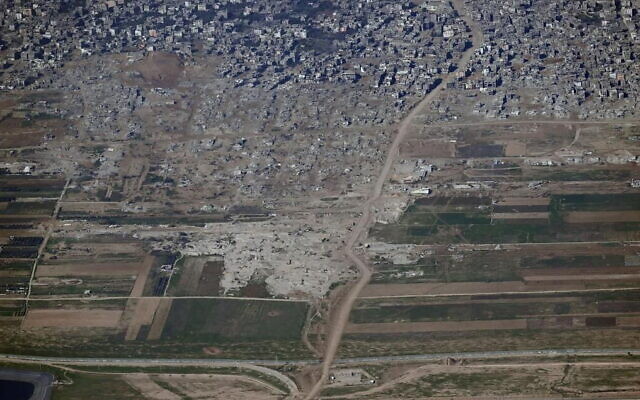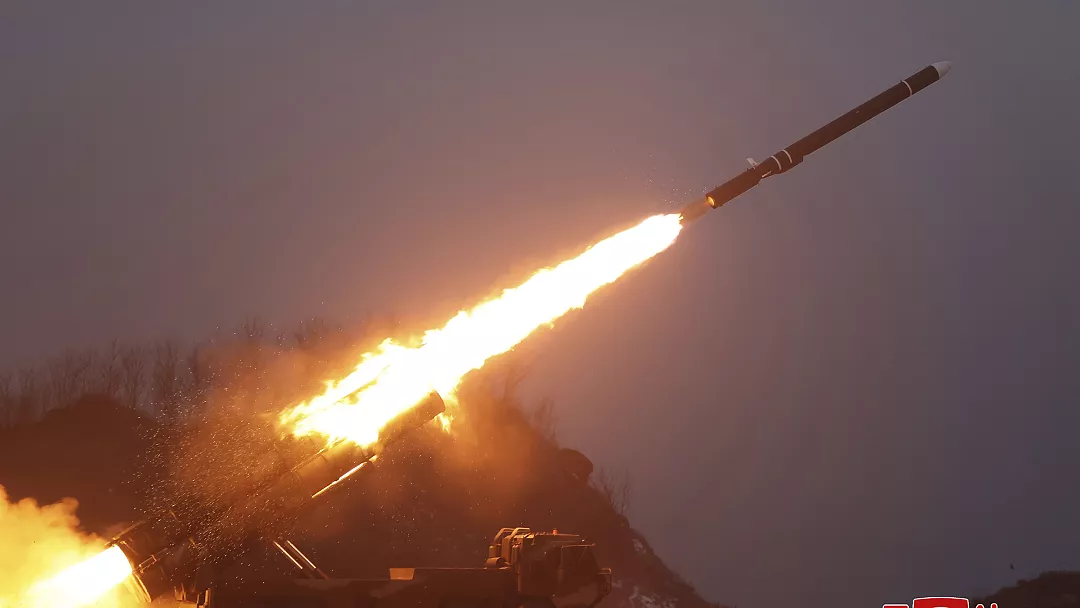
Satellite photos show new demolition within Israeli buffer zone in Gaza
Satellite photos show new demolition along a 1-kilometer- (0.6 mile-)deep path on the Gaza Strip’s border with Israel, according to an analysis by the Associated Press and expert reports. The destruction comes as Israel has said it wants to establish a buffer zone there, over international objections.
The demolition along the path represents only a sliver of the wider damage from the Israel-Hamas war seen in Gaza, which one assessment suggests has damaged or destroyed half of all the buildings within the coastal enclave.
Israeli leaders have signaled that they would like to establish a buffer zone as a defensive measure, which they contend could help prevent a repeat of the shock October 7 cross-border attack by Gaza-ruling Hamas in which terrorists killed some 1,200 people, most of them civilians slaughtered amid brutal atrocities, and kidnapped 253, triggering the nearly four-month-old war. That’s despite US warnings not to shrink Gaza’s territory.
Israel’s military declined to answer whether it is carving out a buffer zone when asked by the AP, only saying that “various imperative actions are needed in order to implement a defense plan that will provide improved security in southern Israel.” However, the military has acknowledged it has demolished buildings throughout the area.
On January 22, 21 IDF soldiers were killed when targeted by Hamas gunmen as they prepared to demolish two buildings in the buffer zone — some 600 yards inside Gaza near Kibbutz Kissufim, one of the communities Hamas terrorists attacked on October 7.
An Israeli government official, speaking on condition of anonymity to discuss ongoing internal deliberations, said a “temporary security buffer zone” is under construction.
But the scope of the demolitions calls into question how temporary the possible buffer zone will be.

Buildings razed in northern Gaza as part of the army’s efforts to establish a buffer zone on the border with the Gaza Strip, as seen in an image provided by the IDF on January 10, 2024. (Israel Defense Forces)
Gaza has a nearly 60-kilometer (37-mile) border with Israel, with the Mediterranean Sea on the other side. Creating that buffer zone would take some 60 square kilometers (23 square miles) out of the Gaza Strip, which has a total landmass of about 360 square kilometers (139 square miles).
Toward the southern part of the Gaza Strip, much of the land in the imagined buffer zone is farmland that abuts the vast $1 billion border barrier constructed on Israeli land that separates it from the enclave. But it’s a different story near the town of Khirbet Khuzaa, where the border turns to the northwest.
Satellite images from Planet Labs PBC analyzed by the AP show significant destruction of buildings and lands bulldozed in a roughly 6-square-kilometer (2.3-square-mile) area. Just over 4 kilometers (2.5 miles) north, farmland has been torn up into bare dirt along where the potential buffer zone would sit.
Further north is an area in central Gaza’s Maghazi refugee camp. There, Israeli reservists preparing explosives to demolish two buildings near the Israeli border were killed in January when Palestinian gunmen fired a rocket-propelled grenade at a tank nearby. The blast triggered the explosives, collapsing both two-story buildings onto the soldiers, killing 21.
A large complex of warehouses sits destroyed just southeast of Gaza City, also within the potential buffer zone.
The AP’s visual analysis corresponds with data from scientists studying satellite data to make sense of the war’s damage.
Adi Ben-Nun, the manager of the Hebrew University of Jerusalem’s Geographic Information System Center, has surveyed damage along the potential buffer zone up until January 17. Of some 2,850 buildings that could potentially face demolition, 1,100 already have been damaged, he told the AP. Across the Gaza Strip, he estimates 80,000 structures have been damaged during the war.

Buildings razed in Gaza City’s Shejaiya neighborhood, as part of the army’s efforts to establish a buffer zone on the border with the Gaza Strip, in an image provided by the IDF on January 10, 2024. The Israel-Gaza border runs across the bottom of the picture. (Israel Defense Forces)
Corey Scher of City University of New York and Jamon Van Den Hoek of Oregon State University put the damage even higher. They estimate at least half of all buildings in Gaza, some 143,900 structures, have been damaged or destroyed during the war. The most intense damage has been around Gaza City — the first city targeted in the ground offensive — though damage has increased in the southern city of Khan Younis.
In the area where the 1-kilometer buffer would be, at least 1,329 buildings have been damaged or destroyed since the war began, the US analysts told the AP.
Gaza’s border with Egypt already has a narrow buffer zone known as Philadelphi Route, which was created as part of Cairo’s 1979 peace deal with Israel.
In December, Israel informed Western allies and regional Arab nations about its plans to create a buffer zone between the Gaza Strip and Israeli territory, Egyptian and Western diplomats told the AP. The discussions then did not include specifics.
News of the buffer zone sparked worries from the international community about eating further into Palestinian territory, particularly in the US, which has been Israel’s main backer during the war.
“We do not support any diminution of the territory of Gaza,” US Secretary of State Antony Blinken warned on January 25.
The State Department did not respond to questions from the AP on the analysis of the demolition in the possible buffer zone. However, State Department spokesperson Matthew Miller on Wednesday told journalists that officials had “raised with (Israel) the issue of the establishment of a buffer zone.”
“I will say we have made clear to them the same thing that we have said publicly, which is we are opposed to any reduction in the size of the territory of Gaza,” Miller said.

State Department spokesperson Matthew Miller answers questions during a news briefing at the State Department on July 18, 2023, in Washington. (AP/Nathan Howard)
On Monday, a US official said to The Times of Israel that Israeli officials have told their American counterparts in recent days that the buffer zone is only meant to be temporary and will be removed once Hamas is completely removed from power.
The US official said that the Biden administration is not on board with even a temporary buffer zone and has voiced that stance with Jerusalem.
Washington believes that, once it is established, Israel will not agree to withdraw from the buffer zone, the US official added.
The foreign ministry of the Palestinian Authority, which oversees parts of the West Bank, said in a statement that “Israel continues to implement its occupation and colonial projects in the Gaza Strip, evident in its recent initiation of what it calls ‘buffer zones’ along the borders of Gaza Strip.”
Senior Hamas official Basem Naim said the terror group was “determined not to let this happen” when asked about the possible Israeli plans for a buffer zone. He did not elaborate.
(Source: The Times of Israel)


